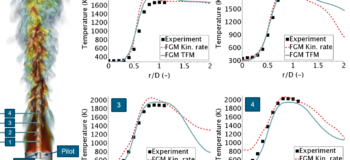CFD speedup at no additional cost has never been that SIMPLE and Consistent
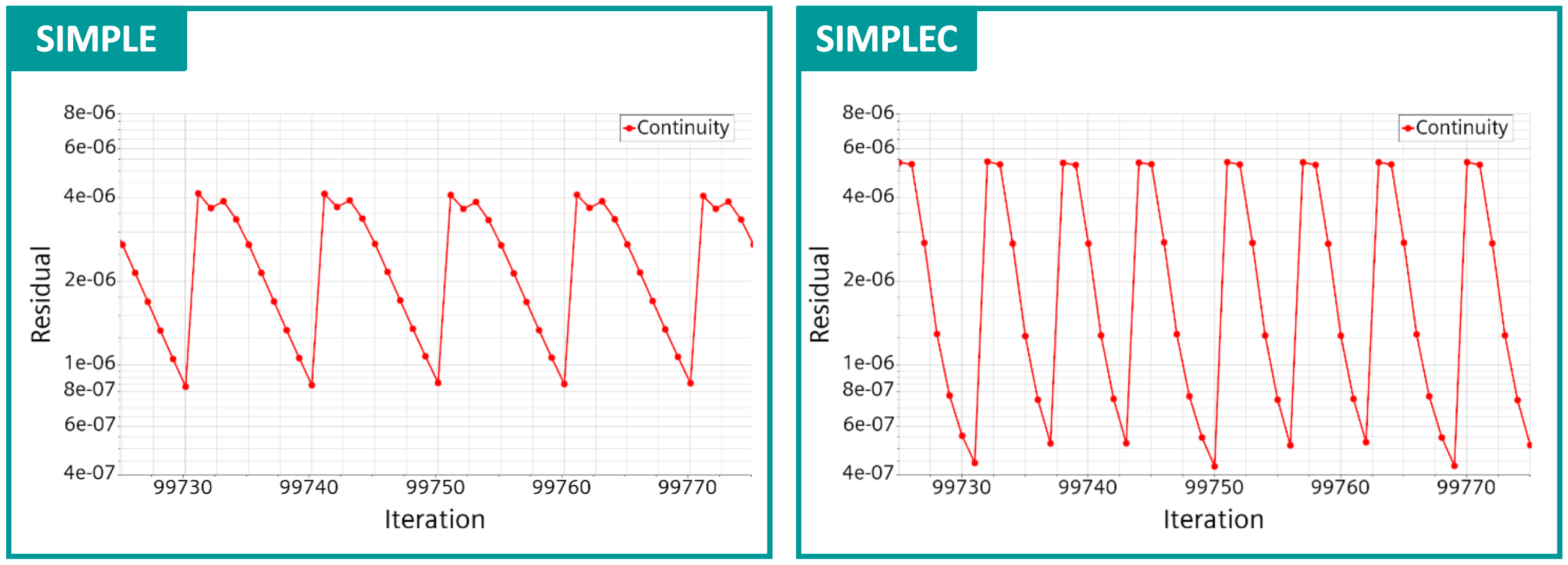
I frankly admit. From time to time I see the world from a slightly different angle. It’s the CFD engineer in me that tilts the world. And so while the vast majority of hikers, climbers and mountain-bikers around me just enjoyed the beauty of the Swiss Alps last summer, I was thinking…
…residuaaaaaaaaaaaaaals dropping…
…as I raced down that hill full of adrenaline on that beast of a downhill bike.

It was a rented bike, latest technology and as I quickly realized, it was quite a thing compared to my own old bike at home. Thanks to the incredibly stable structure of that bike, I could reach speeds that I had never experienced before. I was able to navigate the steepest paths with ease and I was soon flying down the mountain. It was so much fun that I found myself going up and down the hill multiple times that day (also thanks to the chairlift).
Summer is long gone and I had almost forgotten about that rush of adrenaline. Until recently, when SIMPLEC crossed my way.
“SIMPLEC?”, you ask…
Well, let me phrase it like this: if your flow problem was a mountain and my old bike at home was the SIMPLE scheme, SIMPLEC is that beast of a bike that I experienced last summer. But simply see yourself…
CFD speedup – Smarter, not (only) harder!
With every release of new compute hardware technology, CFD simulation can be run faster. As one example, we recently revealed the great benefits of exploiting GPU acceleration to drastically reduce computing time, obtaining a CFD speedup that allows you to run LES simulations overnight! At the same time CPU technology does not stand by idle. In a recent collaboration between Siemens and AMD we benchmarked the brand-new AMD 4th generation processors reporting CFD speedup with massive scalability. To add to this list of faster compute hardware opportunities we will add ARM64 CPU support with the upcoming release of Simcenter STAR-CCM+.
And yet, despite the benefits of modern hardware technology and corresponding CFD software support, the best things in life are free. And so speeding up CFD simulations through more efficient solver techniques is still the most cost-effective way to go faster.
Go faster – CFD speedup with SIMPLEC
If you are a CFD engineer, you should have already encountered the SIMPLE algorithm along your way, either during lectures at university or when setting up your own simulations. SIMPLE stands for Semi-Implicit Method for Pressure Linked Equations and is a numerical scheme widely used to solve the Navier-Stokes equations. In Simcenter STAR-CCM+, we have been using SIMPLE for all steady state solutions and time-accurate transient simulations with the Segregated Flow solver.
In Simcenter STAR-CCM+ 2302, we introduce a new implicit unsteady scheme: SIMPLE-Consistent, better known as SIMPLEC. Compared to SIMPLE, this scheme comes with a modified formulation of the pressure correction equation which does not require under-relaxation. The Under-Relaxation Factor (URF) for Pressure is hence set to 1, and for most of the cases the URF for Velocity can be pushed to 1 too.
Because of no under-relaxation, SIMPLEC shows an improved convergence rate within the time-step and the same convergence as SIMPLE can be reached with less inner iterations per time-step. This effectively gives you CFD speedup on many cases of internal and external unsteady flow involving the segregated flow solver.

Let us have a look at a few applications from the real world.
Accelerate high-fidelity CFD simulations
Faster aeroacoustics simulations
Thanks to the introduction of the Perturbed Wave Convective Equation (PWCE) and the Lighthill Wave hybrid models, the computing time for aeroacoustics CFD simulations in Simcenter STAR-CCM+ has been significantly shortened. On top of this, the enormous acceleration brought by leveraging GPGPU technology has reduced computing times from days to hours. And today SIMPLEC is an additional CFD speedup booster!
Side Mirror Noise aeroacoustics
Aeroacoustics CFD analysis in Simcenter STAR-CCM+ provides you with high accuracy of results and predictive noise levels. The Side Mirror Noise template, developed by our Application Specialist for Automotive External Flows, leverages the potential of the PCWE model and uses convergence-based stopping criteria, in order to ensure high accuracy of results. The performance study shows a reduction of computing time of 22% with SIMPLEC. Running on 8 A100 GPU cards, you can complete a Side Mirror Noise simulation for the 55 M cells AeroSUV test case in 12 hours. This means two configurations per day – a significant CFD speedup!
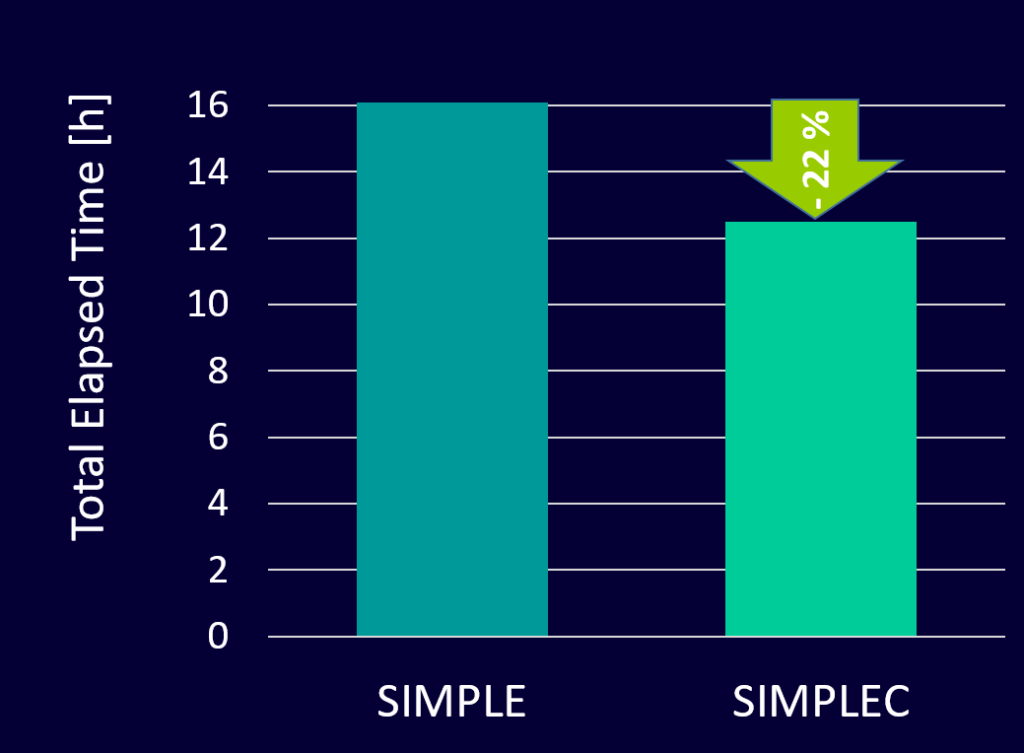

The CFD speedup is achieved thanks to the deeper convergence of SIMPLEC, which satisfies the convergence criteria in 4 iterations, compared to the 6 required by SIMPLE. Having prescribed the same convergence, results are in perfect agreement as shown by the acoustic pressure spectra.
HVAC Noise aeroacoustics simulation
Another target aeroacoustics application is the simulation of HVAC Noise, which we tackle with Large Eddy Simulation (LES) and the Lighthill Wave model. To help engineers conduct these simulations with minimal effort, our Application Specialist for Automotive Cabin Flows built up a ready-to-use template, where also in this case we apply SIMPLEC together with convergence-based stopping criteria. Compared to the old workflow based on SIMPLE, you can now achieve the same results with up to 38% less time. The test case shown here is an industrial HVAC duct, provided by Stellantis. The aeroacoustics CFD simulation was completed in 2.4 hours on 8 A100 GPU cards, with SIMPLEC reaching convergence within 4 iterations per time step leading to excellent CFD speedup.
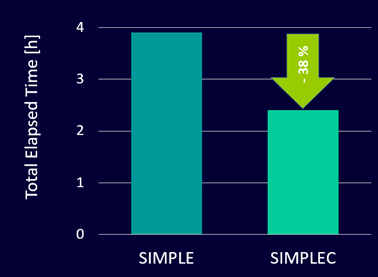
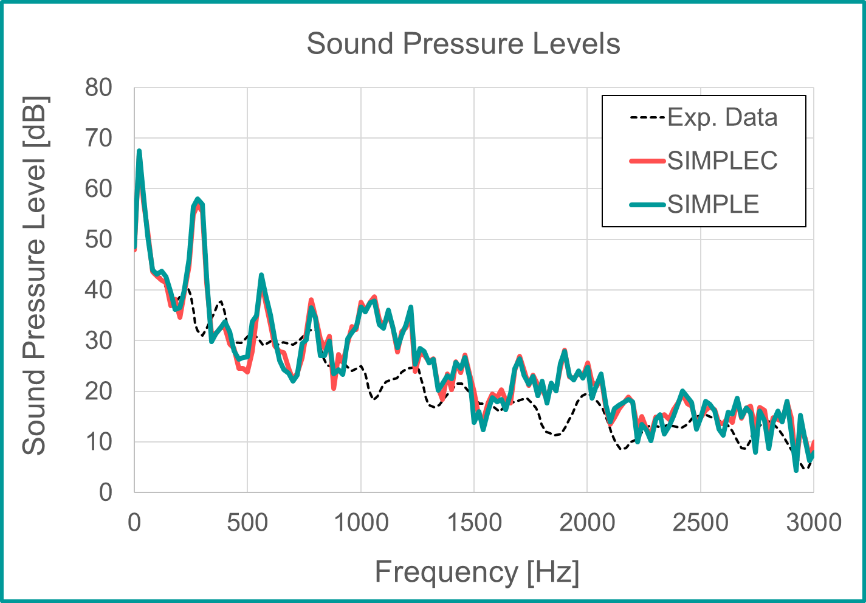
Faster Thermo-acoustics simulation
An industrial gas turbine combustor was simulated using LES and the Flamelet Generated Manifold (FGM) combustion model. Typically, understanding the thermo-acoustic behavior of such combustors requires a 2nd order LES formulation, resulting in high computational load. We carried out a performance test comparing SIMPLEC and SIMPLE, deeming the time-step converged after two orders of magnitude drop in momentum residuals and one order of magnitude drop in continuity residual.
This results in a computing time reduction of about 21%, completing the simulation in about 39 hours on 320 cores of AMD Epyc 7532. Also in this case, the use of convergence-based stopping criteria ensures comparable results. The pressure frequency spectra show very good agreement, predicting a limit cycle of 220-250 Hz, which is in line with what expected from physical tests.

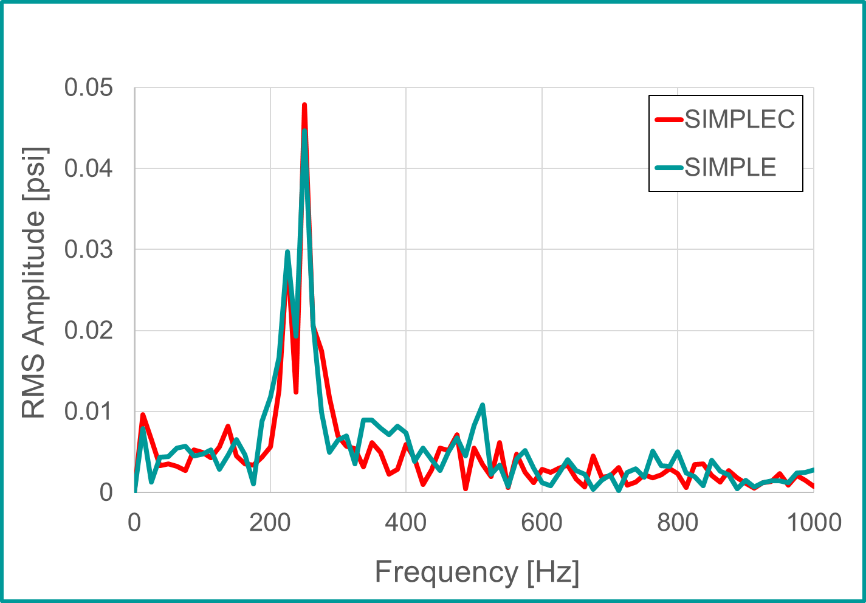
Faster Vehicle External Aerodynamics
With the advent of GPU technology, unsteady DES simulations for vehicle external aerodynamics are expected to become the standard in design processes. Here again, SIMPLEC will bring an extra gear to CFD speedup.
We evaluated it on two cases with different grid sizes. The first one is the AeroSUV model with a grid of 66 M cells. The second is the DrivAer model with a finer grid of 197 M cells. In both cases, SIMPLE and SIMPLEC were compared using convergence-based stopping criteria and a maximum of 10 iterations per time-step to not be exceeded, to achieve an accurate and iterations-insensitive solution.
For both configurations, SIMPLE required all 10 iterations per time-step to drop the continuity residuals of 1 order of magnitude, whereas SIMPLEC could reach convergence in 6 iterations for the AeroSUV and in 7 iterations for the DrivAer. This translates in a speed-up of 38% and 28% respectively, allowing those simulations to be completed in 8 and 24 hours on 16 V100 GPU cards. Once again, the use of convergence-based stopping criteria ensures comparable solutions; a maximum difference of 1 drag count was observed in these two cases.
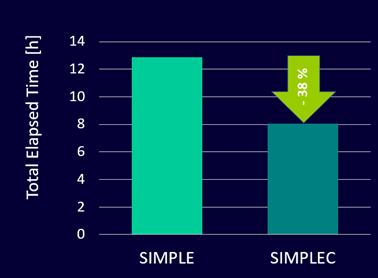
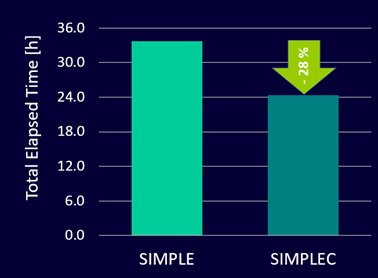
Faster icing simulation for aerospace
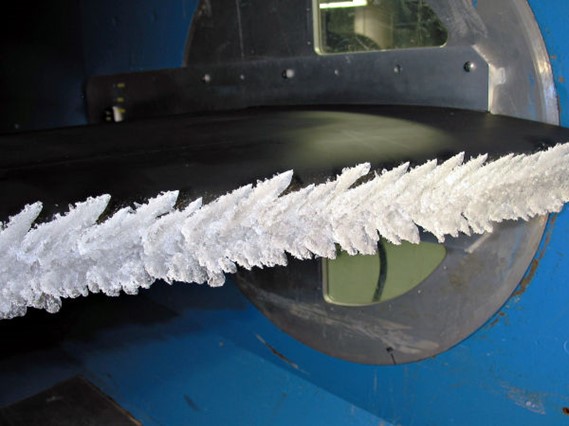
Understanding the phenomena of ice accumulation on wings is key for aerospace engineers during the design stages of an aircraft. One of the most challenging is ice scalloping, a stochastic process that leads to the formation of chaotic ice structures on the leading edge of wings, gradually degrading the aircraft’s aerodynamic performance.
Ice scalloping accretion can be successfully modeled in Simcenter STAR-CCM+ and SIMPLEC is an additional tool that can help engineers get their answers faster. The GLC-350 wing has been simulated in icing conditions (reference: nasa.gov), with a computational grid of around 20 M cells on 160 CPU cores. The simulation of 400 seconds of icing time can now be completed in 5.5 days with a reduction in computing time of about 22% compared to old workflows with SIMPLE.
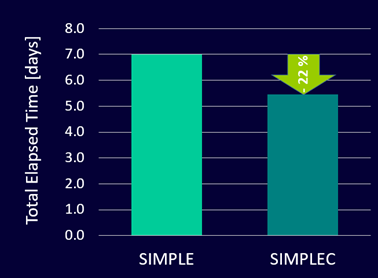
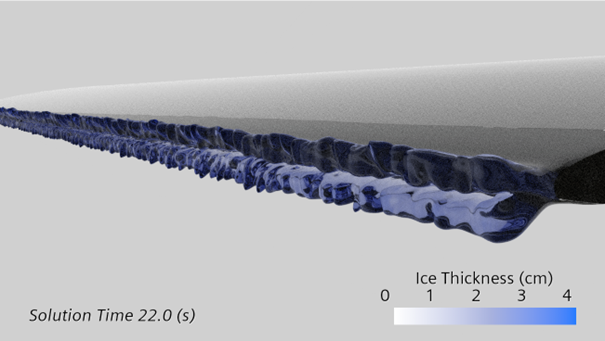
CFD speedup at your fingertips. Converge better, go faster!
Whether it is aeroacoustics, aerodynamics, or icing, SIMPLEC brings great benefits across the board of unsteady flow simulations, delivering CFD speedup with well converged solutions without the need of tweaking solver setups.
Yes, if you feel excited about it, that is the right mood!
Now that I am at home writing these words about (computing) speed and (residuals) drop, my mind goes back again to my downhill rides in the Alps and that bike I rented from the shop. I realize that I have outgrown my good old mountain bike and it is now time for a change.
How about you? Are you ready for an upgrade? Simcenter STAR-CCM+ 2302 is out on February 22. Obtaining CFD speedup of up to 40% at no additional cost has never been that SIMPLE. Enjoy the ride!
Thanks to Simone Landi, Kiran Voona, Liam McManus, Scott Wilensky for the contribution to this work.


